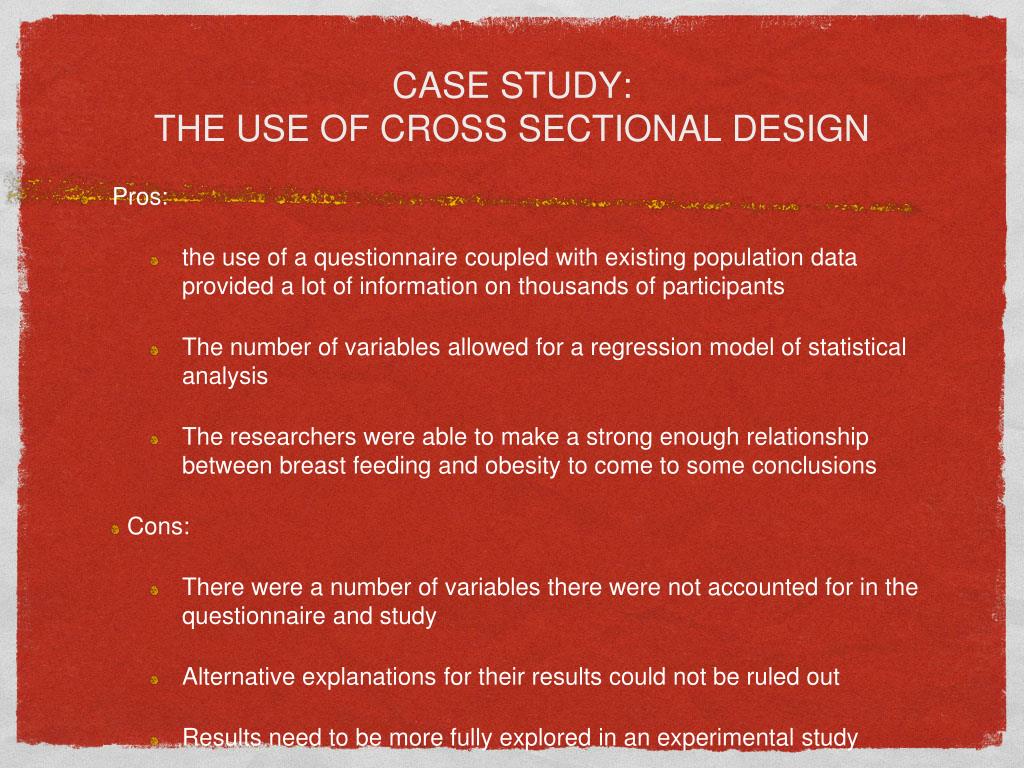Table Of Content

For example, if you’re interested in people’s opinions about vaping and health, a descriptive cross-sectional study would probably be the best approach. In this case, you might use a survey with questions that assess respondents’ beliefs and attitudes towards vaping. However, it is important to remember that surveys designed to capture information about certain aspects of people's lives may not always result in accurate reporting and could cause biases. For example, respondents may not be able to accurately remember or describe their habits and behaviors. Furthermore, there is usually no mechanism to verify the information that survey respondents provide. This is simply a weakness that should be acknowledged when carrying out this type of research.

Key facts about Asian Americans living in poverty
The participants in this type of study are selected based on particular variables of interest. Cross-sectional studies are often used in developmental psychology, but this method is also used in many other areas, including social science and education. One of the primary benefits of cross-sectional studies is their speed and cost-effectiveness, especially when compared to longitudinal studies.
What is the strongest type of study?
Street Transportation 56th Street from Thomas Road to Camelback Road - City of Phoenix (.gov)
Street Transportation 56th Street from Thomas Road to Camelback Road.
Posted: Mon, 27 Feb 2023 19:34:49 GMT [source]
The results suggest that immersion in simulation situations plays a mediating role in the relationship between simulation instructional design and simulation training satisfaction. To increase the simulation educational satisfaction, the scale should be designed by considering the learning goals and contents, support methods during simulation, problem-solving methods, feedback, realism, and building an immersion strategy. First, further research should assess various variables suggested by the NLN/Jeffries simulation theory. Second, it is necessary to develop faculty development programs to improve the ability to apply simulation design and teaching strategies and to determine their effectiveness.
Cross-sectional vs longitudinal studies
Previous ABS studies have found that about 13% of all addresses in the ABS frame were either vacant or not home to anyone in the civilian, non-institutionalized adult population. For this survey, it was assumed that 87% of all sampled addresses from the ABS frame were eligible households. However, this value was not appropriate for the addresses sampled from the list frames, which were expected to have a higher proportion of households as these were maintained lists. For the list samples, the occupied household rate was computed as the proportion of list cases in category 3 compared to all resolved list cases (i.e., the sum of categories 1 through 3). After one week, Westat sent a postcard reminder to all sampled individuals, followed three weeks later by a reminder letter to nonrespondents.
Analytic cross-sectional studies can provide the groundwork to infer preliminary evidence for a causal relationship (Mann, 2012). This design allows investigators to identify a population or sample and collect prevalence data to evaluate outcome differences between exposed and unexposed participants on a disease, phenomena, or opinion (Wang & Cheng, 2020). This design compares the proportion of participants exposed to the disease or phenomena of interest with the proportion of participants non-exposed with the disease or phenomena of interest (Alexander, 2015a). However, determining which variable is the dependent and independent variable or cause and effect is difficult to determine. For example, the association between obesity and hours spent in sedentary behavior among HIV patients (see Table 1). Did the participant become obese due to sedentary behavior, or was the participant inactive due to obesity?
In this case, cross-sectional research designs can provide information about the prevalence of certain attitudes, habits, and behaviors of interests that will be useful for designing more detailed research studies. Another advantage of cross-sectional studies is their ability to collect data on multiple variables simultaneously. This not only saves time and money in data collection, but it also allows you to compare and contrast different data types within the same group of respondents. Another purpose of cross-sectional studies is to infer the nature and strength of relationships between variables. For example, if you’re interested in whether younger people who vape are more or less concerned about their health than older populations, you should gather variables capturing health concerns and age from a target population.
How Do Cross-Sectional Studies Work?
Note that all individuals who self-identified as Asian were asked to complete the extended survey. The aim was to identify challenges and find a solution before commencement of the study. The online data forms for filling data had several quality checks including dosage, units, and that any data with inconsistence variables or errors was instantly rejected. Data analysis was done by experts at the University of Antwerp hence quality is guaranteed. Patient clinical and antibiotic history recorded on their lab request forms or health passports was documented in the excel sheet together with other relevant information. Different culture media used depending on the nature of the sample and suspected pathogen included Blood agar, Chocolate agar, Macconkey agar, XLD agar, CLED, TCBS and Muller Hinton agar.
A cross-sectional analysis might conflate age-related changes with generational effects because different age groups are compared at one particular point in time. Longitudinal research, by observing the same individuals over time, can differentiate between aging effects and cohort effects, offering a clearer view of how specific and multiple variables change throughout an individual's life or over time. In continuing with the obesity and sedentary activity level among HIV participants, the example below (see Table 1) describes the methods for calculating and discussing the results for an analytic cross-sectional study.

Cross-sectional studies: Definition, benefits, and challenges
If learners are not immersed in the simulation, their ability to achieve learning outcomes is not only affected but can also lead to anxiety, which can hamper their collaboration with their peers [11]. This suggests that a simulation design that increases physical, conceptual, and psychological fidelity is necessary to induce flow, as flow increases students’ motivation, enjoyment, and satisfaction with the learning process. The significance of the current study lies in its confirmation of the link between simulation design and simulation educational satisfaction, as well as the mediating function of flow. Nursing students can achieve simulation educational satisfaction through simulation-based education if simulation educators follow best practices that improve flow through well-organized simulation design. It’s a tool that allows researchers to collect data across a pre-defined subset or sample population at a single point in time. The information is typically about many individuals with multiple variables, such as gender and age.
Epidemiology may also be considered the method of public health—a scientific approach to studying disease and health problems. A cross-sectional study does not need to have a control group, as the population studied is not selected based on exposure. Cohort studies, on the other hand, begin by selecting a population of individuals who are already at risk for a specific disease. Unlike cross-sectional studies, researchers can use longitudinal data to detect changes in a population and, over time, establish patterns among subjects. The information obtained from cross-sectional studies enables researchers to conduct further data analyses to explore any causal relationships in more depth. They can be beneficial for describing a population or “taking a snapshot” of a group of individuals at a single moment in time.
A narrower CI indicates a higher level of precision versus a wider CI suggesting a lower level of precision (Cummings, 2013). The sample size also impacts the CI’s width, with larger sample sizes providing a more precise estimate. The approximate value of the point estimate is based on factors (i.e., characteristics like body weight, level of activity) such as the mean (average) of a population from a population’s random samples. The PR measures the prevalence of an outcome in the exposed group, divided by the unexposed group, and measures the association’s strength between the exposure and outcome (Alexander, 2015). Excess prevalence (EP) or the risk difference (RD) provides the difference in prevalence between the groups and indicates how much additional prevalence is due to the exposure of interest (Alexander, 2015b).
For example, researchers may find that people who reported engaging in certain health behaviors were also more likely to be diagnosed with specific ailments. While a cross-sectional study cannot prove for certain that these behaviors caused the condition, such studies can point to a relationship worth investigating further. This type of research can be used to describe characteristics that exist in a community, but not to determine cause-and-effect relationships between different variables. This method is often used to make inferences about possible relationships or to gather preliminary data to support further research and experimentation.
Though these studies cannot determine cause and effect, they are invaluable for generating hypotheses or propositions, informing policy decisions, and guiding future research. Their descriptive nature and relative ease of execution make cross-sectional studies a common starting point in many research endeavors, providing a foundational understanding of the context and variables of interest. Furthermore, suppose the prevalence of a disease or phenomena is low, less than ten percent in the exposed and unexposed population (sample).
Each item was scored on a 5-point Likert scale ranging from 1 point (strongly disagree) to 5 points (strongly agree). The total score ranged from 10 to 50, with a higher score indicating a higher level of flow in simulation-based education. Although researchers can't use cross-sectional studies to determine causal relationships, these studies can provide useful springboards to further research. For example, when looking at a public health issue, such as whether a particular behavior might be linked to a particular illness, researchers might utilize a cross-sectional study to look for clues that can spur further experimental studies. Cross-sectional studies are observational in nature and are known as descriptive research, not causal or relational, meaning that you can't use them to determine the cause of something, such as a disease. Researchers record the information that is present in a population, but they do not manipulate variables.
Such a study could compare test scores to analyze trends and disparities in educational achievement. By examining variables like socio-economic status, teaching methods, and school resources, educators and policymakers can identify areas needing improvement or intervention. Cross-sectional studies are employed across various disciplines to investigate multiple phenomena at a specific point in time. These studies offer insights into the prevalence, distribution, and potential associations between variables within a defined population. The authors presented a cross-sectional analysis to assess the prevalence of HIV and risk behaviors in male sex workers. The data were collected by interviewer-administered questionnaires (for sociodemographic and behavior data), clinical evaluation for sexually transmitted infections (STIs), and serological evaluation for STIs (including HIV).
In this study, we recognized a problem of multidrug resistance in patients experiencing clinical failure in a variety of clinical syndromes such as genital discharges, dysuria, abscess and persistent temperatures. The findings underline the need for strengthening antimicrobial stewardship programmes such AMR surveillance. The consistently decline in sensitivity of the most locally used antibiotics including ciprofloxacin, ceftriaxone, gentamycin, doxycycline, and ampicillin signifies the growing resistances of bacterial pathogens due to overuse over the past 3 decades [24, 25]. According to the findings of the PPS, ceftriaxone and metronidazole emerged as the leading antibiotics prescribed in the wards. The findings are in agreement with other studies conducted in sub-Saharan African region which established penicillins, ceftriaxone and metronidazole to be the most prescribed antibiotics with an extended prescribing of up to 6 days for surgical patients [26].

No comments:
Post a Comment